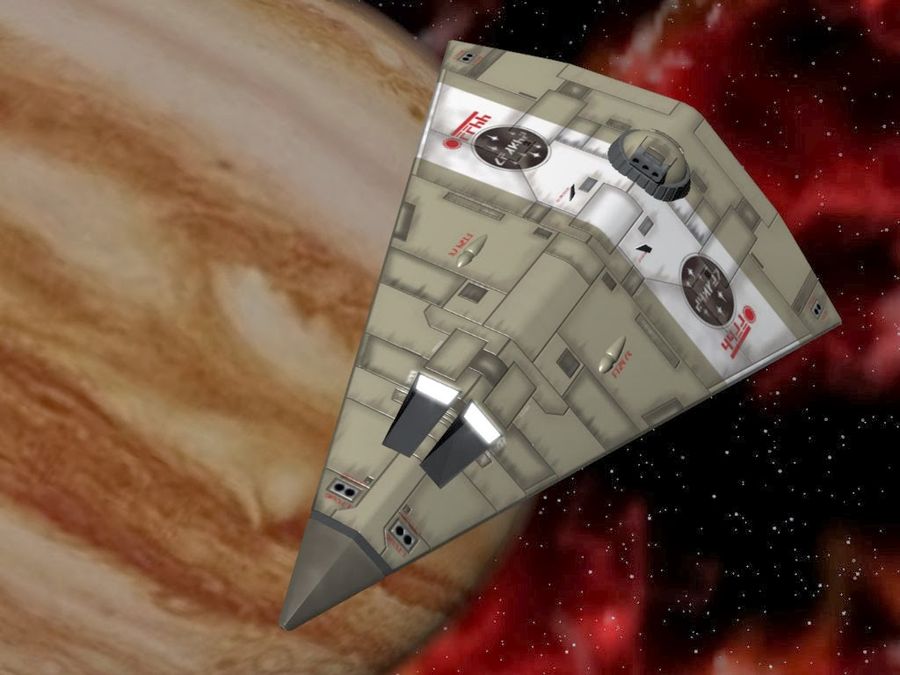As I slid back into playing in an AD&D campaign as well as running a twice-a-month Dimmermount-based campaign, I poked my nose back into Traveller. Namely - I had a few years back purchased the Classic Traveller CD-ROM from FFE which included the complete LBB's of the original edition as well as the consolidated "Traveller Book" edition, and all of the expansion books: High Guard for more advanced ship design and naval character skills, as well as expansions for scouts, ground forces, merchants, various adventures and deckplans, as well as many of the original boardgames from that era including Fifth Frontier War.
And I was happy. Bluntly, as I've mentioned before, the original Traveller rules, especially when separated out from the Third Imperium background, are amazingly flexible and, if you assume they're not broken, solve a lot of issues present in other, later, skills-based systems. As a result, not having an interest in the later game editions, I avoided most of the later editions, though I did pick up a copy of Cepheus Engine, and liked what I saw, which can be considered an opens source Traveller clone, apparently based on the Mongoose release.
I avoided T5 like the plague, no matter that Marc Miller was deeply involved. Everything I heard put it down for being too heavy on charts and tables, too detailed, too difficult, too big. I now suspect that many of these complaints came from people not intimately familiar with CT, or who had since bought into newer-style role-play assumptions than those that permeated B/X, AD&D, and later, ACKs.
A friend of mine picked it up, and got excited. He reported that yes, there were tables - but they were clean, well organized, and allowed you to quickly look up what you needed to know - say, a rough travel time between planets in a system - without having to do a lot of calculations. That the character and task resolution system were simple and straightforward. Since he's done professional wargaming design for people who live and die by the results, I decided to give it a shot.
And so far, I'm glad I did. In one example, the charts elaborating how the different range bands apply to human and space-scale combat and encounters, as well as how they translate to oceanic abysses vs mountains, altitude, low orbit, and other geography at a human scale, makes it easy to work with situations that are not at a close combat/tactical level as well as describe what's going on.
That said, what was gold was the chapter "The Foundations of the Traveller Universe", which shows how much thought went into not only the changes made to this edition, but into the base assumptions since day one of CT. This chapter is broken up into a section describing an assumption of how tech/the universe works, and then how it affects character play and decisions.
TECHNOLOGICAL SCIENCE IS A FOUNDATION
The technological basis for Traveller provides a common ground from which all story ideas are built.The Jump Drive
The secret of interstellar travel is the Jump Drive.
RealSpace limits travel to the speed of light (and to years of travel between stars); jump drives propel ships be- tween stars in a matter of weeks. A simple jump covers a parsec (3.26 light years) in about a week. Improved drives can reach up to six times that speed, or more.
Nevertheless Jump Drive has its drawbacks: require- ments for (literally) tons of fuel, specialized power sources, and careful astrogation, all of which challenge the players as they pilot ships from world to world.
The Jump Drive and JumpSpace concepts make star travel both easy to achieve and easy to understand.
Communication Limited To Transportation Speed
The universe is so vast that even the mega-speeds of jump drive can’t work miracles. No one has yet invented a hyper-communicator that will send messages faster than the speed of light. Communication is limited to the speed of transportation; a message to the edge of the empire needs to be literally carried there. For an empire 300 parsecs across, that message takes more than a year to deliver, even under the best of circumstances. News of war, conflict, invasion, disaster, or even peace takes just as long to get back to the center of government.
Consequently the individuals governing “out there” have a lot of independence. A war can be over before the news of it reaches the Capital –and reactive orders return– so Dukes and Archdukes have to act on their own. Commanders of ships have a lot of independence as well. The characters have to think on their own–if they work for a merchant com- pany, opening new markets, they can’t “phone home” every time negotiations break down–and on the other hand, the company needs to accept all sorts of wacky contracts and situations!
A communication speed limit establishes an independence for characters at great distances from their superior. Situations demand resourcefulness and initiative.
It goes on in this vein. Under why different tech levels are elaborated : Different levels of technology allow players significant alternatives in how they approach situations. Later, under describing the standard gravity tech available in much of the setting, the rationale is, in part: Gravity Manipulation makes its easier for players to conceptualize the actions of their characters; illustrations are more understandable if they simply show people standing up.
In short, he wanted to make the universe comprehensible so that the GM and players, with a minimum of scientific knowledge, could start and play a game, while maximizing the number of real choices and courses of action available to them.
Other things I found interesting, or funny:
The following observation about different races/aliens in the universe - Traveller accepts diversity and allows (even requires) a wide variety of beings to interact for their mutual benefit. Such a universe is richer than a purely human environment. - is followed by an observation that Differences breed conflict. In many cases, that conflict can be resolved with words and negotiation. On the other hand, violence and the threat of violence are integral parts of the universe of the Traveller universe.
The concept that proximity and differences cause conflict and war is borne out by history.
The universe assumed in the rules is primarily human - and primarily, again, for ease of player familiarity. It also follows:
Everything Is Driven By Economics
Economics is not strictly the study of finance; it is the study of making choices between and among limited possi- bilities. Regardless of the pronouncements of political, mor- al, or cultural leaders, action in this universe takes place be- cause it will produce some economic advantage. Economic advantage generally means rewards in a monetary sense, but it can also mean rewards in political or social power. Be- hind all lies some economic motive.
Players can understand what happens in Traveller be- cause it is driven by the same elements that drive all human (or sophont) endeavor: economics.
The rules explicitly state that there is no artificial and nonsensical "prime directive" to constrain player actions. On the other hand, there are still consequences, and the far flung, independent nature of the setting means that duty, honor, and loyalty matter.
Interstellar society naturally values people (human or not) on whom it can depend: those who are loyal and who faithfully do their duty are the ones to whom society awards responsibility. A natural nobility arises of those leaders of so- ciety who faithfully and with innovation follow the orders of their superiors. At the same time, superiors have learned to express their orders in the most general of terms: to give greater freedom of action.
People with responsibilities are expected to act respon- sibly. If they do not, they won’t hold their positions for long.
It is actually damned refreshing to see actual virtues explicitly not only promoted, but baked into a game setting.

